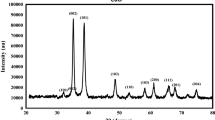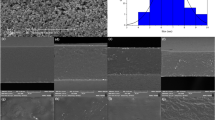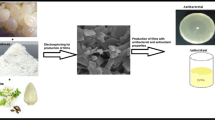Abstract
In this research copper nanoparticles (Cu NPs) were incorporated in the biodegradable hydroxypropyl methylcellulose (HPMC) matrix using the simple and low cost chemical reduction method for application as food packaging material. The properties of Cu/HPMC bionanocomposites (BNCs) were studied as a function of the CuSO4 concentration. Surface morphology of the film was investigated by scanning electron microscopy. Mechanical analysis and water vapor barrier properties of HPMC/Cu nanocomposites were analyzed. It was observed that mechanical and water vapor barrier properties of the films were improved by the concentration of CuSO4. The antibacterial activity of HPMC/Cu thin films were evaluated based on the diameter of inhibition zone in a disk diffusion test against Gram positive bacteria, ie, Streptococus A., S. epidermidis, S.aureus , B.cereus and Gram negative bacteria, ie, E. coli, E. faecalis, Salmonella, P. aeruginosa using Mueller Hinton agar at different concentration of CuSO4. The results revealed a greater bactericidal effectiveness for nanocomposite films containing 5 % of CuSO4. Packages prepared from HPMC/Cu nanocomposite films were used for meat packaging. The films were filled with meat and then stored at 4 °C. Microbial stability of the meat was evaluated after 3, 7, 10 and 15 days of storage. The results showed that microbial growth rate significantly reduced as a result of using this nanocomposite packaging material.







Similar content being viewed by others
References
Angles MN, Dufresne A (2001) Plasticized starch/ Tunicin Whiskers nanocomposites. Macromolecules 34:2921–2931
Balasubramaniam VM, Chinnan MS, Mallikarjunan P, Phillips RD (1997) The effect of edible film on oil uptake and moisture retention of a deep-fat fried poultry product. J Food Process Eng 20:17–29
Belcher JN (2006) Industrial packaging developments for the global meat market. Meat Sci 74:143–148
Cornforth, D. and Hunt, M. (2008). Low-oxygen packaging of fresh meat with carbon monoxide. Meat quality, microbiology, and safety. AMSA White Paper Series, Number 2, pp. 1-10. American Meat Science Association, Savoy, Illinois, USA.
De Silva DJ, Olver JM (2005) Hydroxypropyl methylcellulose (HPMC) lubricant facilitates insertion of porous spherical orbital implants. Ophthal Plast Reconstr Surg 21(4):301–2
Faundez G, Troncoso M, Navarrete P, Figueroa G (2004) Antimicrobial activity of copper surfaces against suspensions of Salmonella enterica and campylobacter. BMC Microbiol 4:19–25
Feng QL, Wu J, Chen GQ, Cui FZ, Kim TN, Kim JO (2000) A mechanistic study of the antibacterial effect of silver ions on Escherichia coli and Staphylococcus aureus. J Biomed Mater Res 52(4):662–668
Hiroyasu K (2003) The applications and functions of hydroxypropyl methylcellulose as a new food additive. Foods Food Ingredients J Jpn 208:6
Imran M, El-Fahmy S, Revol-Junelles A-M, Desobry S (2010) Cellulose derivative based active coatings: effects of nisin and plasticizer on physico-chemical and antimicrobial properties of hydroxypropyl methylcellulose films. Carbohydr Polym 81:219–225
Kawashita M, Tsuneyama S, Mijaji F et al (2000) Antibacterial silver containing silica glass prepared by the sol-gel method. Biomaterials 21:393–398
Kester JJ, Fennema OR (1986) Edible films and coatings: a review. Food Technol 40:47–59
Kim JS, Kuk E, Yu K, Kim JH, Park SJ, Lee SJ et al (2007) Antimicrobial effects of silver nanoparticles. Nanomedicine: Nanotechnol Bio Med 3:95–101
Krochta JM, Mulder-Johnston C (1997) Edible and biodegradable polymer films: challenges and opportunities. Food Technol (Chicago) 51:61–74
Larsen G, Noriega S (2004) Dendrimer-mediated formation of Cu- CuOx nanoparticles on silica and their physical and catalytic characterization. Appl Catal A Gen 278:73–81
Lee D, Cohen RE, Rubner MF (2005) Antibacterial properties of Ag nanoparticle loaded multilayers and formation of magnetically directed antibacterial microparticles. Langmuir 21:9651–9659
Lok CN, Ho CM, Chen R, He QY, Yu WY, Sun H et al (2006) Proteomic analysis of the mode of antibacterial action of silver nanoparticles. J Proteome Res 5:916–924
Márquez G., Ordóñez J. A., Cambero M. I., Cabeza M. C. Use of E-Beam for Shelf-Life Extension and Sanitizing of Marinated Pork Loin. International Journal of Microbiology. (2012). Article ID 962846, 12 pages.
Mary G, Bajpai SK, Chand N (2009) Copper alginate-cotton cellulose (CACC) fibers with excellent antibacterial properties. J Eng Fiber Fabr 4:24–35
Morones JR, Elechiguerra JL, Camacho A et al (2005) The bactericidal effect of silver nanoparticles. Nanotechnology 16:2346–2353
Moura MRD, Mattoso LH, Zucolotto V (2012) Development of cellulose-based bactericidal nanocomposites containing silver nanoparticles and their use as active food packaging. J Food Eng 109:520–524
Ninnemann KW (1968) Measurements of physical properties of flexible films. In: Sweeting OJ (ed) Science and Technology of Polymer Films. Interscience, London, England, pp 546–649
Patel MK, Nagare BJ, Bagul DM, Haram SK, Kothari DC (2005) Controlled synthesis of Cu nanoparticles in fused silica and BK7glasses using ion bean induced defects. Surf Coat Technol 196:96–99
Ruparelia JP, Kumar CA, Duttagupta SP, Diao M, Yao M (2009) Use of zero-valent iron nanoparticles in inactivating microbes. Water Res 43:5243–5251
Sawai J (2003) Quantitative evaluation of antibacterial activities of metallic oxide powders (ZnO, MgO and CaO) by conductimetric assay. J Microbiol Methods 54(177):182
Tilaki RM, Iraji ZA, Mahadavi SM (2007) Size, composition and optical properties of copper nanoparticles prepared by laser ablation in liquids. Appl Phys A Mater Sci Process 88:415–4192
Torres JA (1994) Edible films and coatings from proteins. In: Hettiarachchy NS, Ziegler GR (eds) Protein Functionality in Food Systems. IFT Basic Symposium Series. Marcel Dekker, New York, pp 467–507
Wang H, Huang Y, Tan Z, Hu X (2004) Fabrication and characterization of copper nanoparticles thin-films and the electrocatalytic behavior. Anal Chim Acta 526:13–17
Williams RO, Sykora MA, Mahaguna V (2001) Method to recover a lipophilic drug from hydroxypropyl methylcellulose matrix tablets. AAPS Pharm Sci Tech 2(2):E8
Yoon K, Byeon JH, Park J, Hwang J (2007) Susceptibility constants of Escherichia coli and Bacillus subtilis to silver and copper nanoparticles. Sci Total Environ 373:572–5
Young HK, Yu-ri C, Kwang-Mahn K, Se-Young C (2012) Evaluation of copper ion of antibacterial effect on Pseudomonas aeruginosa, Salmonella typhimurium and Helicobacter pylori and optical, mechanical properties. Appl Surf Sci 258:3823–3828
Zhu H, Zhang C, Yin Y (2005) Novel synthesis of copper nanoparticles: influence of the synthesis conditions on the particle size. Nanotechnology 16:3079–3083
Author information
Authors and Affiliations
Corresponding author
Rights and permissions
About this article
Cite this article
Ebrahimiasl, S., Rajabpour, A. Synthesis and characterization of novel bactericidal Cu/HPMC BNCs using chemical reduction method for food packaging. J Food Sci Technol 52, 5982–5988 (2015). https://doi.org/10.1007/s13197-014-1615-0
Revised:
Accepted:
Published:
Issue Date:
DOI: https://doi.org/10.1007/s13197-014-1615-0




